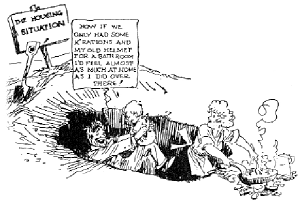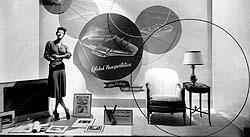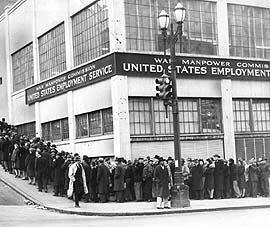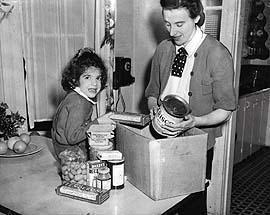By Sharon Boswell
and Lorraine McConaghy
Special to The Times
 As Americans slogged through the home-front deprivations of World War II, they were
encouraged to dream of a prosperous future with consumer products of every kind: lightweight plastic
appliances, synthetic fabrics and streamlined automobiles. But postwar realities were very
different. Here, syndicated cartoonist "Ding" Darling satirized the acute housing shortage on a Seattle Times
editorial page, while local unemployment and strikes claimed the newspaper's headlines.
As Americans slogged through the home-front deprivations of World War II, they were
encouraged to dream of a prosperous future with consumer products of every kind: lightweight plastic
appliances, synthetic fabrics and streamlined automobiles. But postwar realities were very
different. Here, syndicated cartoonist "Ding" Darling satirized the acute housing shortage on a Seattle Times
editorial page, while local unemployment and strikes claimed the newspaper's headlines.
ON THE HOME FRONT, AMERICANS DREAMED OF THE WORLD OF PLENTY THAT PEACE WOULD BRING. The GI Bill of Rights,
passed in 1944, entitled every veteran to attend college or technical school and to borrow money
to buy a house. Women's magazines published "wish lists" for readers to plan their future homes,
room by room. In Seattle, Frederick & Nelson display windows showcased the World of Tomorrow, when
industry would offer everything from push-button kitchens to personal aircraft.
World War II had followed hard on the heels of the Great Depression. For 15 years, people worried about
the future and postponed their plans. When the war was over, they hoped to get on with their lives,
the sooner the better.
 In 1943, passers-by peering into this futuristic Frederick &
Nelson window hoped for an end to home-front worry, sorrow and shortages.
In 1943, passers-by peering into this futuristic Frederick &
Nelson window hoped for an end to home-front worry, sorrow and shortages.
Photo Credit: Museum of History and Industry.
MAYOR WILLIAM DEVIN FORMED THE SEATTLE AREA CITIZENS COMMITTEE in February 1944 to design the postwar future.
The Chamber of Commerce also published studies that anxiously calculated the number of jobs needed
to stave off bitter postwar unemployment.
In March 1944, 300,000 industrial workers were employed in the Puget Sound region. At war's end,
the Chamber anticipated that 12,000 workers would go back to Arkansas or Chicago and an additional
12,000 women would return to their kitchens. However, nearly 38,000 veterans would come home
to enter the work force. To balance the more than 100,000 jobs expected to vanish with peacetime,
the region would need 122,000 new ones.
Try as they might to dream of push-button kitchens, Americans dreaded the return of hard times.

In early 1946, 8,000 men and women filed for benefits each week at the U.S. Employment Service offices in Seattle.
Photo Credit: Seattle Times.
AS MILITARY CONTRACTS ENDED OVERNIGHT, A GRIM BATTLE FOR INDUSTRIAL SURVIVAL BEGAN.
A number of shipyards hung out a For Sale sign
rather than move from Navy production back to trawlers and ferries. Boeing experimented desperately with
automobile and furniture manufacture, and lobbied for spending to develop military aircraft.
Boeing B-29 production declined from 155 in August 1945 to only 10 in October.
Then, with a backlog of completed bombers, the company shut down the line.
Likewise, nearly 200,000 men and women had worked in Puget Sound shipyards;
by 1946, the shipbuilding force had fallen to 10,000. Wages went into free fall for workers
lucky enough to still have jobs, and unions struck back to protect their members and hold their wartime gains.
Five million Americans went on strike in 1946, including members of
the United Mine Workers, the United Auto Workers, the United Steel Workers and various railroad brotherhoods.
The Seattle Times and other local papers were shut down by a 56-day printers strike.
The newspaper's first post-strike edition detailed local walkouts by telephone workers, bus drivers,
loggers, machinists and blacksmiths. Throughout 1946 and 1947, The Times published a stream of
editorials and editorial cartoons depicting the United States' postwar recovery held hostage by
labor racketeers and radicals.
In 1947, Congress scaled back New Deal gains for labor. Overriding President Harry Truman's
veto, it passed the Taft-Hartley Act, which forbade closed shops and required 60 days' notice to strike.
On May 24, 1947, the Aero-Mechanics Union No. 751 voted overwhelmingly to reject Boeing pay
increases of pennies per hour. When the union's international refused to sanction a strike, both
parties dug in for a yearlong stalemate. Then, in April 1948, 14,000 mechanics walked off the job anyway
-- for 140 days.
Americans resented the continued state of emergency, whatever its cause. When wartime controls
were removed, inflation drove prices through the roof and there were shortages, from building materials to beer
to new cars.

Mrs. Herbert Tannhauser and daughter Sylvia packed food in 1947 to send to hungry relatives in Europe.
Mrs. Tannhauser was a Jewish refugee from prewar Nazi Germany. Photo Credit: Seattle Times.
AS MEN RETURNED FROM WAR, AN UNPRECEDENTED MARRIAGE AND BABY BOOM hit the
United States, and an acute housing shortage resulted. The Times featured the plight of
the Hamilton family of five, who lived in a 12-by-14 tent. Laid off at a local shipyard,
driven from home-front housing, Alex Hamilton had found a new job driving a bread truck but --
like thousands of others -- was unable to find a place to rent.
In 1947, President Truman introduced a catchy phrase -- "Save Meat, Save Wheat,
Save the Peace" -- to sweeten a Spartan program of Meatless Tuesdays and Eggless Thursdays to send
food to hungry Europe.
Two years after the war, with meatless meals, strikes, shortages and no new cars,
cynics who didn't blame organized labor blamed the president, jibing, "To err is Truman."
But the Depression didn't return, and Seattle survived the aches and pains of conversion.
Eventually, there would be enough places to live, shortages would end, prices would stabilize, and
most people would find jobs. The hot war was finally over; the Cold War was just beginning.
Historians Sharon Boswell and Lorraine McConaghy teach at local universities and do research,
writing and oral history. Original newspaper graphics courtesy of the Seattle Public Library.